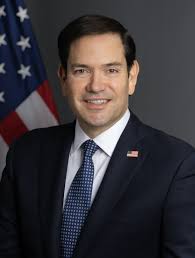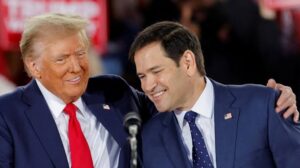Marco Rubio Hegseth: parents,ethnicity,Trump’s War Cabinet,net worth

Marco Rubio. Age: 54 | Secretary of State Net worth: $1.5 million. Son of Cuban immigrants. Today we will discuss about Marco Rubio Hegseth: parents,ethnicity,Trump’s War Cabinet,net worth
Marco Rubio Hegseth: parents,ethnicity,Trump’s War Cabinet,net worth
When Donald Trump assembled his second administration, two names stood out among his security and diplomacy picks: Marco Rubio as Secretary of State and Pete Hegseth as Secretary of Defense. These two figures carry distinct personal backgrounds, political trajectories, and public profiles. In this article, we examine their family origins, ethnic identities, how they came to join Trump’s “war cabinet,” and what is publicly known about their net worth.
We will begin with Rubio, then shift to Hegseth, and finally comment on how their roles form part of Trump’s foreign and defense strategy apparatus.
Marco Rubio: Origins, Family, Ethnicity

Early Life and Family Background
Marco Antonio Rubio was born on May 28, 1971, in Miami, Florida. He is the third of four children of Mario Rubio Reina and Oriales (née García) Rubio. His parents emigrated from Cuba in 1956, prior to the Cuban Revolution, and settled in the United States.
Although Rubio often frames himself as a “son of exiles” fleeing Castro’s regime, investigations suggest some embellishment: his parents were admitted to permanent residence before Castro took power in 1959. Still, Rubio’s immigrant background is central to his political narrative.
Mario worked variously as a bartender and in service jobs; Oriales worked in hotel housekeeping and factory work. The family briefly moved to Las Vegas, where Rubio was baptized a Mormon (Latter-day Saints), before later returning to Florida, where his family rejoined the Catholic Church.
In genealogical records, Rubio is identified as of Cuban American / Hispanic heritage.
Education and Early Career
Rubio graduated from South Miami Senior High School in 1989. He spent one year at Tarkio College in Missouri on a modest football scholarship, then transferred to Santa Fe Community College in Florida, and later to the University of Florida, where he earned a B.A. in political science in 1993. He then pursued his Juris Doctor degree (cum laude) at the University of Miami School of Law, graduating in 1996.
While in law school, Rubio interned for U.S. Representative Ileana Ros‑Lehtinen, a significant early political connection. After graduating, he worked as a lawyer and began his public office run.
He entered politics in local government, serving on the West Miami City Commission in 1998–2000, then was elected to the Florida House of Representatives (2000–2008). In the Florida House, he rose to Majority Leader and then Speaker (2006–2008).
In 2010, Rubio won election to the U.S. Senate, serving from January 2011 to January 2025.
Rubio’s Role in Trump’s War Cabinet
When Trump began assembling his second administration, he named Rubio as Secretary of State, and later assigned him additional “acting” roles, effectively placing several national security posts under his oversight.
Nomination and Confirmation
Trump announced Rubio’s nomination for Secretary of State in November 2024, and Rubio was unanimously confirmed by the Senate (99–0) on Inauguration Day, January 20, 2025. Rubio thus became the first confirmed member of Trump’s second-term Cabinet.
Expanding Portfolio: Acting Positions
In April/May 2025, Trump designated Rubio to serve additionally as Acting National Security Advisor, while retaining his Secretary of State role. He also holds acting title as Archivist of the United States and previously as USAID Administrator before USAID’s abolition.
This stacking of roles has sparked criticism, including concerns that Rubio may be overstretched. Effectively, Rubio is positioned at the nexus of diplomacy, intelligence, and security, coordinating across multiple domains in Trump’s war cabinet structure.
Pete Hegseth: Origins, Ethnicity, Career
Early Life, Family, Ethnicity
Peter Brian Hegseth, born June 6, 1980, is of Norwegian descent. He was born in Minneapolis, Minnesota. His parents are Brian Hegseth and Penelope “Penny” (née Haugen) Hegseth. Brian worked as a high school basketball coach; Penelope is a business coach and leadership educator. Unlike Rubio’s immigrant Cuban heritage, Hegseth stems from a more established American/Norwegian-American lineage.
Military, Media, and Political Career
Hegseth graduated from Princeton University, where he was the publisher of The Princeton Tory. In 2003, he joined the Army National Guard / ROTC, receiving commission and later serving in Guantánamo Bay, Iraq, and Afghanistan.
Following his military service, Hegseth became involved in veterans’ advocacy, leading organizations like Vets for Freedom and Concerned Veterans for America. In 2014, he joined Fox News as a contributor and eventually co-hosted Fox & Friends Weekend.
In 2024, Trump selected Hegseth as his nominee for Secretary of Defense. In Senate confirmation hearings, he faced scrutiny over his views on women in combat, past allegations, and his relative lack of civilian defense management experience. Ultimately, his confirmation passed by a narrow margin, with Vice President JD Vance casting a tiebreaking vote.
In his early tenure as Defense Secretary, Hegseth announced the termination of the Pentagon’s Women, Peace & Security (WPS) program, despite Rubio being one of the original congressional co-sponsors of that law.
How Rubio & Hegseth Fit into Trump’s War Cabinet
Together, Rubio and Hegseth form the twin pillars of Trump’s security and foreign policy apparatus. Rubio leads diplomacy and intelligence coordination; Hegseth commands military strategy and the Department of Defense.
Strategic Overlap & Tension
-
Policy alignment and friction: While Rubio has publicly backed programs like Women, Peace & Security during his congressional career, Hegseth’s push to dismantle it signals potential internal disagreements.
-
Communication & transparency: Allegations have arisen regarding the use of private messaging apps to discuss military operations, raising questions around record-keeping and oversight. Rubio has sought to distance himself from sharing operational plans.
-
Public perception and balance: Critics argue that Rubio, holding multiple roles, may be stretched too thin.
In the architecture of Trump’s war cabinet, Rubio handles external diplomacy, strategic intelligence coordination, and overall security posture, while Hegseth directs defense planning, operations, and military institutional reforms.
Net Worth & Financial Profile
Estimating net worth for public figures is always approximate. Here’s what is known for both Rubio and Hegseth.
Marco Rubio’s Net Worth
Rubio’s financial disclosures and media reports suggest a modest net worth relative to many high-profile politicians.
-
Assets versus liabilities: Non–real estate assets ranged up to about $205,000. Liabilities (student loans, mortgage, other debts) were in the range of $525,000 to $1,065,000. This suggests a negative net worth on paper.
-
Real estate and home equity: Rubio owns a home in West Miami, purchased in 2021 for under $1 million, estimated in 2024 to be worth about $1.75 million. Mortgage debt remains substantial.
-
Book deals and royalties: Rubio earned a substantial advance for An American Son and receives royalties from subsequent books.
Estimates by media generally place Rubio’s net worth around $1 million, though some calculations based on assets minus liabilities suggest negative net worth.
Pete Hegseth’s Net Worth
Hegseth’s financial profile is less transparent but likely higher than Rubio’s:
-
Estimates range from $1 million to $6 million, factoring in media earnings, publishing revenue, and real estate.
-
His federal salary as Defense Secretary is approximately $246,400 annually.
Hegseth’s financial background, combining private earnings and media career, likely exceeds Rubio’s net worth, though exact figures remain speculative.
Comparative Summary and Implications
| Feature | Marco Rubio | Pete Hegseth |
|---|---|---|
| Ethnic / family origin | Cuban American | Norwegian American |
| Parents / upbringing | Father: Mario, bartender; Mother: Oriales, housekeeper/factory worker | Father: Brian, coach; Mother: Penelope, leadership educator |
| Path to security roles | Senator, Secretary of State, multiple acting roles | Military service, media career, Secretary of Defense |
| Net worth (public estimates) | ~$1 million | ~$1–6 million |
Rubio’s immigrant narrative, legislative experience, and modest personal wealth contrast with Hegseth’s media-driven career and larger financial resources. Their partnership represents Trump’s preference for placing loyalists and ideological conservatives in key national security posts.
Challenges, Critiques & Future Questions
Financial Transparency & Debt
Rubio’s negative net worth highlights economic pressures of public service, with liabilities primarily from mortgage debt. Hegseth’s net worth is less transparent, raising potential questions about conflicts of interest given defense procurement responsibilities.
Role Overreach & Workload
Rubio’s multiple acting roles risk overextension, potentially affecting execution and leadership effectiveness.
Institutional and Policy Tensions
Hegseth’s dismantling of WPS highlights policy tensions between the two officials. Transparency concerns over private messaging apps for discussing military operations also remain a potential risk.
Public Perception & Political Future
Rubio’s immigrant-rooted narrative remains politically valuable. Hegseth’s rise from media to Pentagon illustrates influence politics but questions managerial experience. Their ability to coordinate and manage disagreements will shape reputations and future political prospects.
Conclusion
Marco Rubio and Pete Hegseth, from very different personal and political origins, now sit at the core of Donald Trump’s war cabinet. Rubio brings an immigrant narrative, legislative experience, and modest personal wealth. Hegseth contributes military credentials, media influence, and arguably greater financial resources. Together, they form the twin axes of diplomacy and defense strategy in Trump’s second term.
Their success depends not only on geopolitical events and crises but on how well they coordinate, manage internal policy differences, and maintain institutional integrity under scrutiny. For readers, the story of Rubio and Hegseth is not just about wealth or biography—but about how personal history, political trajectory, and ideology converge in the highest stakes of national security.
How useful was this post?
Click on a star to rate it!
Average rating 0 / 5. Vote count: 0
No votes so far! Be the first to rate this post.
About the Author
usa5911.com
Administrator
Hi, I’m Gurdeep Singh, a professional content writer from India with over 3 years of experience in the field. I specialize in covering U.S. politics, delivering timely and engaging content tailored specifically for an American audience. Along with my dedicated team, we track and report on all the latest political trends, news, and in-depth analysis shaping the United States today. Our goal is to provide clear, factual, and compelling content that keeps readers informed and engaged with the ever-changing political landscape.




